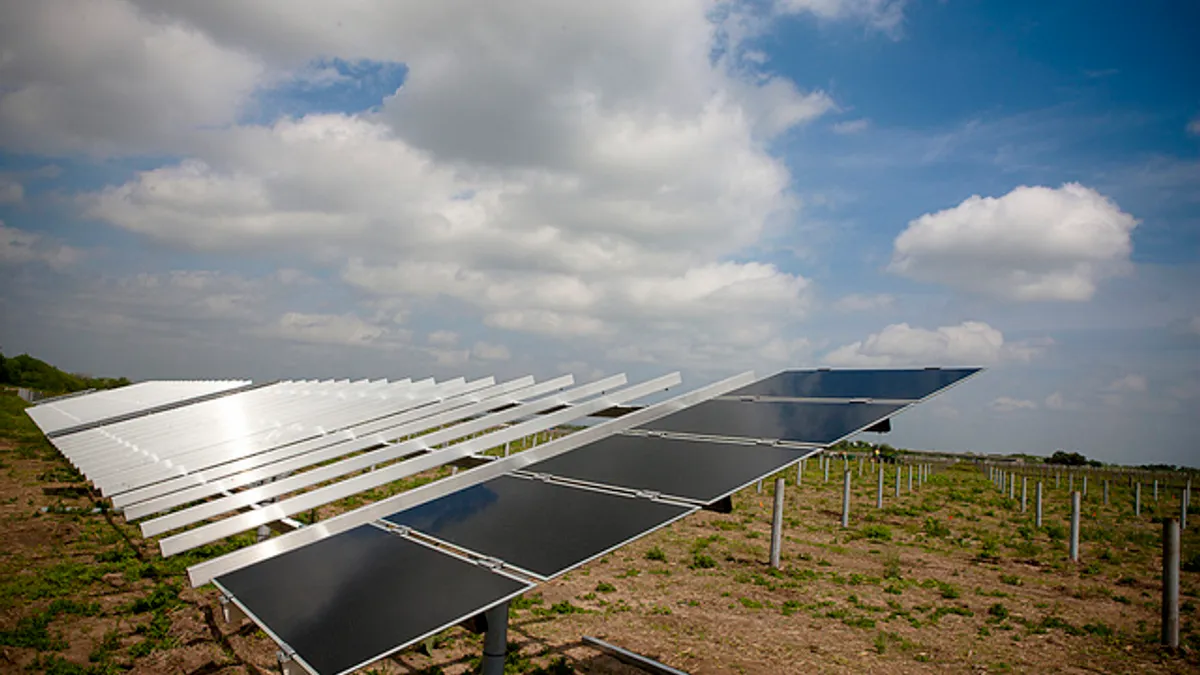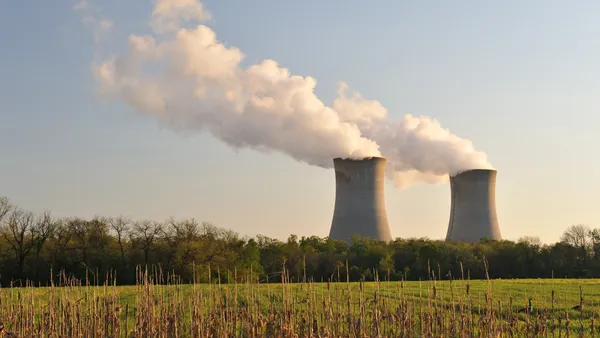Dive Brief:
- The Trump administration issued a decision on a high-profile trade case, imposing 30% tariffs on imported crystalline silicon photovoltaic modules and cells. The first 2.5 GW of cell imports of every year are excluded, according to the press release, which offered no details on whether or not some countries are exempt from the tariffs. Implementation starts in 15 days.
- The tariffs will decline in 5% increments over a four-year span, ending at 15% by 2022. The decision draws from one of the three separate recommendations issued by the U.S. International Trade Commission last year in a rare Section 201 of the Trade Act of 1974 proceeding, and excludes a floor price and quotas recommended by two United States-based solar manufacturers last year.
- According to GTM Research, a 30% tariff pencils out to roughly $0.10-$0.15/watt, which could reduce utility-scale solar installations by 9%. Trump's decision will likely mean the demise of the petitioners, Suniva and SolarWorld. Both companies told Utility Dive that without their proposed duties, which are markedly higher than the final decision, they would likely fold. However, these tariffs would benefit domestic thin film manufacturer First Solar, who came out in support of tariffs last year.
Dive Insight:
Months of uncertainty have finally ended with Trump's decision.
The final decision appeared to draw upon an ITC recommendation from Commissioners David Johanson, a Republican appointed by former President Barack Obama and Irving Williamson, a Democrat appointed by former President George W. Bush. Both commissioners recommended a 30% tariff that would decline in 5% increments over the four-year span.
The controversy started in April when two U.S.-based solar manufacturers petitioned for import relief using a rare Section 201 global safeguard measure. Suniva, a Georgia-based manufacturer, is under the Chapter 11 bankruptcy process. SolarWorld joined in May after its German parent company filed for insolvency. Both parties blamed low-price imports, mostly from Chinese companies based in other countries, for their predicament.
Both companies asked for strong tariffs, a floor price and quota that they said would help them get into the black and revive the battered domestic solar manufacturing space. However, the case was almost universally panned, particularly by the Solar Energy Industries Association, which headed the primary challenge against the petition. At stake were tens of thousands of jobs.
Now SEIA estimates the job losses will number 23,000 for this year, and result in "billions lost in investment." SEIA President Abigail Hopper condemned Trump's decision in a statement.
"While tariffs in this case will not create adequate cell or module manufacturing to meet U.S. demand, or keep foreign-owned Suniva and SolarWorld afloat, they will create a crisis in a part of our economy that has been thriving, which will ultimately cost tens of thousands of hard-working, blue-collar Americans their jobs,” she said.
The majority of the current 260,000 solar jobs are in installation, with only 38,000 (or 14%) in manufacturing. Moreover, the case threatened two-thirds of future utility-scale solar installations set to come online in the next five years, which is the biggest and most vulnerable solar market. Experts compared the solar trade case to the last Section 201 proceeding, which targeted imported steel.
Unlike steel, solar could be easily swapped for gas and wind, opponents testified in the marathon hearings. Most notably, utilities Duke Energy and NextEra spoke out against the trade case; historically, they have fought against substantial solar installation before the resource declined in costs.
It also marked a time for strange alliances — Trump's conservative allies, including Heritage Foundation and the American Legislative Exchange Council, also condemned the push for tariffs.
The duties will remain in place for the full four years under Section 201, but will likely see a challenge at the World Trade Organization. Countries, such as China, could also levy retaliatory tariffs on exports from states with prominent GOP Congressmen, such as Senate Majority Leader Mitch McConnell (R-KY) and House Speaker Paul Ryan (R-WI). According to Shayle Kann, senior advisor to GTM Research, most, if not all Section 201 duties which have seen challenges at the WTO did not remain in place the full four years.
The uncertainty has already dented solar projects in the U.S. A significant one in Texas was put on hold, and NextEra representative Michael O'Sullivan noted in a public hearing, "there's a chilling affect on the market that started a few months ago."
Anne Hoskins, chief policy officer of major residential solar installer Sunrun said solar growth will rest on state policy and lawmakers.
"We look to state governors, legislators and public utility commissioners with huge solar workforces, from South Carolina to New York to California, to step up to overcome this short sighted federal action," Hoskins wrote in an email to Utility Dive. "Now more than ever, states must take steps to ensure that solar will continue to lead the transition to a more resilient and clean energy system."
But for others, the decision to strike a more middle-of-the-road approach did not come as a surprise. Varun Sivaram, a fellow at the Council on Foreign Relations who predicted the Trump administration would impose a 30% tariff last year, wrote in an email to Utility Dive that "deployment could take a 10% hit relative to no tariffs."
Suniva and SolarWorld thanked Trump for his decision their statements, promising to work with the federal government to implement the tariffs.
"We are still reviewing these remedies, and are hopeful they will be enough to address the import surge and to rebuild solar manufacturing in the United States," said Juergen Stein, President of SolarWorld Americas in a statement emailed to Utility Dive. However, there is no word yet on their next steps.
It remains to be seen how the market will respond to this decision and whether the utility investment will continue. However, the U.S.Trade Representative Robert Lighthizer noted the administration will work with other "interested parties" on a resolution regarding earlier anti-dumping and counter-veiling measures levied on Chinese and Tawain imports a few years ago, also at the behest of SolarWorld. In retaliation, China had issued tariffs on U.S. polysilicon manufacturing.
Lighthizer's statement reflects a proposal from NRG Renewables CEO Craig Cornelius, who pushed for these talks back in December during the last public hearing. This could result in exemptions for some countries, but it's unclear where these additional settlements will lead to in the long run.
Editor's note: The post has been updated to include reactions and more analysis.













